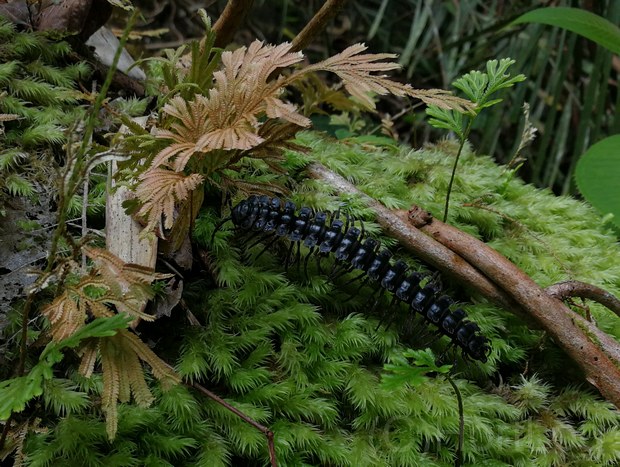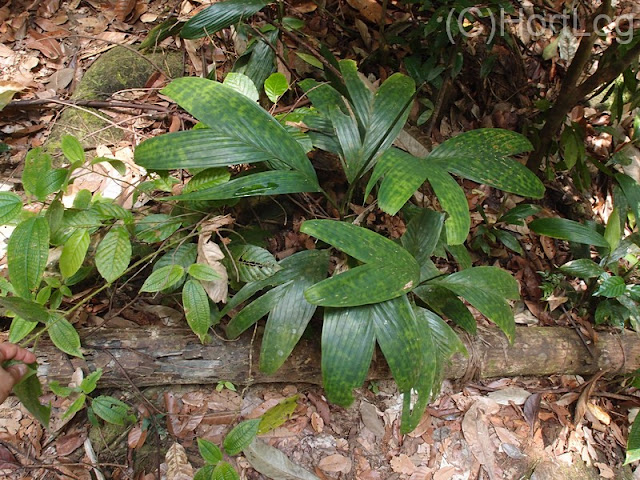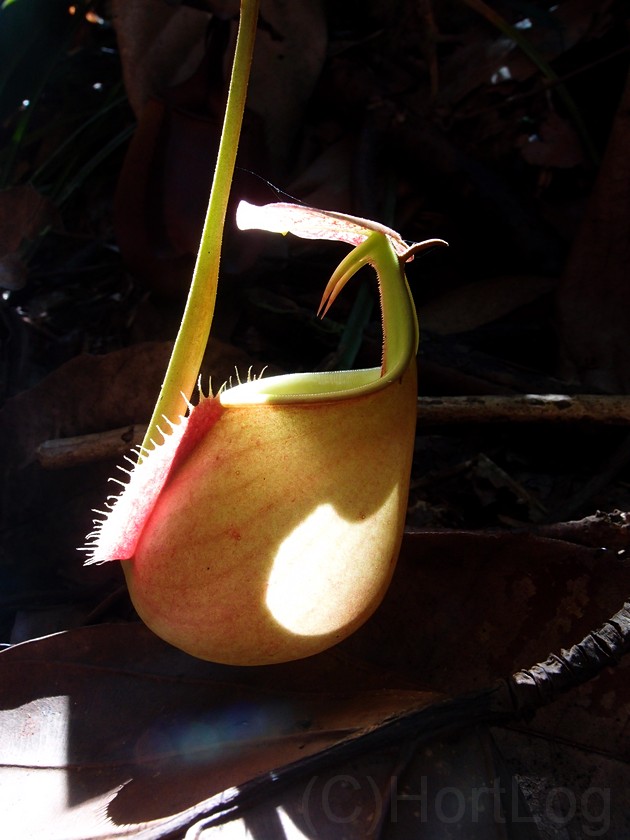Let the feelings flow
For love, when its real, is rare and beautiful
Friday, August 24, 2018
Labels:
Musing
Saturday, August 4, 2018
Steam Punk Friday
Like a ridiculously armoured locomotive with legs, the Barydesmus or tractor millipede saunters across different terrains effortless thanks to its well syncronised limb movements.
.... this one looks like it's made by a carpenter....
... and this one looks like the work of an iron smith ....

....check out the copper coloured Selaginella which completes the surreal setting perfectly.
.... this one looks like it's made by a carpenter....
... and this one looks like the work of an iron smith ....

....check out the copper coloured Selaginella which completes the surreal setting perfectly.
Labels:
Critters
Friday, July 13, 2018
Sander's dream
Initially discovered in 1885 in Sarawak, this bizarre slipper orchid was thought to be extinct until it was rediscoverd in 1978. It was so rare and so sought-after that it became the plant poster-child of the ill-concieved Convention on International Trade of Endangered Species (CITES for short).
Instead of smothering the collection of plants in the wild, CITES
actually increase the black market value of many slipper orchid species,
most of which were rather drab and unexciting anyway but became
interesting to collectors of the rare and contraband. There were also
unofficial accounts that during the development of an air-strip in Mulu
area, the habitat of limestone Paphiopedilums, including this species,
was destroyed but no one took effort to salvage the plants for fear of
infringing CITES regulations. Nowadays, it was reported to be only found only
within the Mulu National Park, I am not sure if that is true now but its distribution used to be wider.
Saturday, June 9, 2018
Into the woods
Burning the road for three hours or so up north eventually lead us to a green heaven, albeit a steamy one.
As soon we stepped out of the cosy automobile into this sauna of a place, we were greeted by a welcome party ....
... a troop of dusky leaf monkey (Trachypithecus obscurus). These are obligate herbivores and most of them have a pot belly as digesting the leaves is a slow inefficient process and hence they tend to over eat. I consider them to be the most adorable monkey in Malaysia due to their peaceful nature and impish looking face.
This particular fearless young guy caught my eyes as it fed nonchalantly on the young leaves just above me.
Fallen while still so glorious, like Kim Jonghyun or James Dean before him perhaps ..... the spent bloom of an Syzgium.
The stilt roots of a tall Dillenia (possibly D. reticulata), showed that this area is seasonally flooded, especially during the year end monsoon.
We were stopped short by a singular tree with a population of these sap-sucking red-nosed lantern flies (Fulgoridae ).
From another angle they look even more ridiculous - the function of the red-tipped horns remained elusive.
Amydrium medium is a climbing aroid with nice juvenile foliage that turns rather nondescript as it matures.
The rare small palm Licuala kiahii resides in this neck of the woods. East and West Malaysia has the highest diversity of Licuala in the world although to casual observers they look rather similar.

Pinanga disticha is a common palm in this area - it has beautiful mottled foliage. This has great horticultural value and is not difficult to grow in a sheltered location indoor.
The very interesting Phyllanthus griffithii which is endemic in West Malaysia.

The distinctive flower and fruits of a Sterculia....
... usually these are giant trees growing in more open area but this small species appear to prefer shade.
A couple of the so called corpse flower follows - the common Amorphophallus paenifolius which is fruiting ....
....and the much rarer Amorphophallus bufo - which I have yet to see flower despite encountering them many times.
....and finally, what a glorious spot to wash our smelly dirty feet .....
"There's no wifi in the woods but you will find a better connection" ....hmmm I am not sure .... we were just trespassing this dark realm, like rolling stones really.....too keen to get back to our comfort zone, too impatient to sync with nature's channel....
Labels:
Aroid,
Critters,
Herbaceous,
Lowland evergreen forest,
Palms and Cycads
Friday, June 1, 2018
Tuesday, May 29, 2018
Bugs Busters of Borneo
The nutrients-poor soil of the kerangas and peat swamp forest have driven many plants to supplement their autotrophic existence by other nutritional means. Borneo has an astonishing variety of such plants - as I discovered during a day trip at a kerangas bordering a peat swamp forest .
Under the full glare of the sun and on persistantly wet sandy area, the sundew Drosera burmanii coexist with a population of bladderwoth Utricularia - which would almost be unnoticeable were it not for the yellow bloom.
The tentatcles of the Drosera burmanii are tactile and produce both a sweet fluid and a sticky glue - these attracts insects from which they then surround and entrap. The speed of movement of the tentalces in this species is one of the fastest in the genus - closing in on the prey between 5-10 seconds.
The dimunitive nature of these plants mean that they easily be outcompete by larger, faster growing plants in richer soils so they are restricted in bright, acidic and nutrient-poor area
The pitcher plant genus Nepenthes has the most diversity in Borneo and Philippines. Unlike the previous species, Nepenthes do not have movable parts to ensnare their prey. One of the largest lowland species Nepenthes rafflesiana shown below- demonstrate its usual modus operandi - trapping, drowning and assimilating invertebrates in its large pitchers. Note the large lid sheltering the pitcher in this photo - it serves to prevent dilution of the digestive enzymes from rain water.
This species was actually first discovered in Singapore by Dr William Jack in 1819.

Nepenthes ampullaria, on the other hand, has a tiny lid, which flips away from from the pitcher opening. This species does not catch much insects - instead it relies on leaf debris and other organic waste dropping into the pitchers and so it clearly wants the lid out of the way. Its pitchers also do not have slippery inner wall and very little nectar gland which produce insect attractants....
....the plant branches repeatedly to form a network of pitchers on the floor. This maximise the capture rate of any fallen organic matter.The red-pitcher form is very attractive and has great horticulture value. It seems to be restricted to Borneo
The red speckled form is common throughout its range.
The Borneo endemic Nepenthes bicalcarata has a pair of downward facing fangs growing from the the pitcher peristome. The function of this is still a matter of debate. Although it feeds on the carpenter ants that nests in its tendrils, it also benefits from a symbiotic way since the ants are shown to provide housekeeping service by removing excess undigested organic material, thereby preventing bacterial / fungal proliferation and early demise of the pitchers.


The pitchers are medium size and the red variety is quite horticultural.
While most Nepenthes are indiscriminate when it comes to food, Nepenthes albomarginata is rather picky - specialising in trapping termites. This species has a ring of pale hairy cells around the rim of the pitchers which somehow termites cannot resist feeding. The inevitable eventually happens and the pitcher will soon be filled with termites after sacrificing some strands of hairs.
There are 2 forms - the lowland green form .....
and the attractive dark form from higher elevation.
Nepenthes mirabilis is one of the most widely distributed species and the normal form has rather unremarkable attributes although the variety echinostoma, which I could not find, has surreal and weird peristome. In my previous post I had found pitchers filled with ants.
The pictures below look very much like the lower pitchers of N. rafflesiana but I think it is the hybrid with N. ampullaria known as Nepenthes xhookeriana
This is another hybrid, I believe Nepenthes rafflesiana x mirabilis and it appears that one of the parent is very red. Natural hybrid is very common amongst Nepenthes particularly in high diversity area like Borneo where the different species co-exist in the same area.
Labels:
Carnivorous,
Kerangas,
Peat Forest
Subscribe to:
Posts (Atom)














































